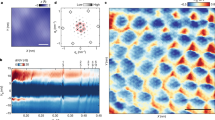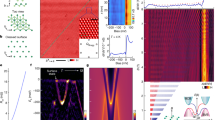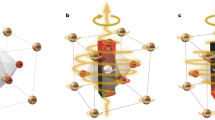Abstract
Topological phases of matter have captured our imagination over the past few years, with tantalizing properties such as robust edge modes and exotic non-Abelian excitations, and potential applications ranging from semiconductor spintronics to topological quantum computation. Despite recent advancements in the field, our ability to control topological transitions remains limited, and usually requires changing material or structural properties. We show, using Floquet theory, that a topological state can be induced in a semiconductor quantum well, initially in the trivial phase. This can be achieved by irradiation with microwave frequencies, without changing the well structure, closing the gap and crossing the phase transition. We show that the quasi-energy spectrum exhibits a single pair of helical edge states. We discuss the necessary experimental parameters for our proposal. This proposal provides an example and a proof of principle of a new non-equilibrium topological state, the Floquet topological insulator, introduced in this paper.
This is a preview of subscription content, access via your institution
Access options
Subscribe to this journal
Receive 12 print issues and online access
$209.00 per year
only $17.42 per issue
Buy this article
- Purchase on Springer Link
- Instant access to full article PDF
Prices may be subject to local taxes which are calculated during checkout





Similar content being viewed by others
References
Bernevig, B. A., Hughes, T. L. & Zhang, S. C. Quantum spin Hall effect and topological phase transition in HgTe quantum wells. Science 314, 1757–1761 (2006).
König, M. Quantum spin Hall insulator state in HgTe quantum wells. Science 318, 766–770 (2007).
Hsieh, D. et al. A topological Dirac insulator in a quantum spin Hall phase. Nature 452, 970–974 (2008).
Xia, Y. et al. Observation of a large-gap topological-insulator class with a single Dirac cone on the surface. Nature Phys. 5, 398–402 (2009).
Zhang, H. et al. Topological insulators in Bi2Se3, Bi2Te3, Sb2Te3 with a single Dirac cone on the surface. Nature Phys. 5, 438–442 (2009).
Fu, L. & Kane, C. L. Superconducting proximity effect and Majorana fermions at the surface of a topological insulator. Phys. Rev. Lett. 100, 096407 (2008).
Moore, G. & Read, N. Nonabelions in the fractional quantum Hall effect. Nucl. Phys. B 360, 362–396 (1991).
Žutić, I., Fabian, J. & Das Sarma, S. Spintronics: Fundamentals and applications. Rev. Mod. Phys. 76, 323–410 (2004).
Nayak, C., Simon, S. H., Stern, A., Freedman, M. & Das Sarma, S. Non-Abelian anyons and topological quantum computation. Rev. Mod. Phys. 80, 1083–1159 (2008).
Kitagawa, T., Rudner, M. S., Berg, E. & Demler, E. Exploring topological phases with quantum walks. Phys. Rev. A 82, 033429 (2010).
Sörensen, A. S., Demler, E. & Lukin, M. D. Fractional quantum Hall states of atoms in optical lattices. Phys. Rev. Lett. 94, 086803 (2005).
Lin, Y. J., Compton, R. L., Jimenez-Garcia, K., Porto, J. V. & Spielman, I. B. Synthetic magnetic fields for ultracold neutral atoms. Nature 462, 628–632 (2009).
Stanescu, T. D., Galitski, V., Vaishnav, J. Y., Clark, C. W. & Das Sarma, S. Topological insulators and metals in atomic optical lattices. Phys. Rev. A 79, 053639 (2009).
Oka, T. & Aoki, H. Photovoltaic Hall effect in graphene. Phys. Rev. B 79, 081406(R) (2009).
Mani, R. G. et al. Zero-resistance states induced by electromagnetic-wave excitation in GaAs/AlGaAs heterostructures. Nature 420, 646–650 (2002).
Zudov, M. A., Du, R. R., Pfeiffer, L. N. & West, K. W. Evidence for a new dissipationless effect in 2D electronic transport. Phys. Rev. Lett. 90, 046807 (2003).
Auerbach, A. & Pai, G. V. Nonlinear current of strongly irradiated quantum Hall gas. Phys. Rev. B 76, 205318 (2007).
Dmitriev, I. A., Vavilov, M. G., Aleiner, I. L., Mirlin, A. D. & Polyakov, D. G. Theory of microwave-induced oscillations in the magnetoconductivity of a two-dimensional electron gas. Phys. Rev. B 71, 115316 (2005).
Inoue, J. & Tanaka, A. Photoinduced transition between conventional and topological insulators in two-dimensional electronic systems. Phys. Rev. Lett. 105, 017401 (2010).
Haldane, F. D. M. Model for a quantum Hall effect without Landau levels: Condensed-matter realization of the ‘parity anomaly’. Phys. Rev. Lett. 61, 2015–2018 (1988).
Schnyder, A. P., Ryu, S., Furusaki, A. & Ludwig, A. W. W. Classification of topological insulators and superconductors in three spatial dimensions. Phys. Rev. B 78, 195125 (2008).
Kitaev, A. Periodic table for topological insulators and superconductors. AIP Conf. Proc. 1134, 22–30; (2009) preprint at http://arxiv.org/abs/0901.2686.
Thouless, D. J., Kohmoto, M., Nightingale, M. P. & den Nijs, M. Quantized Hall conductance in a two-dimensional periodic potential. Phys. Rev. Lett. 49, 405–408 (1982).
Novik, E. G. et al. Band structure of semimagnetic Hg1−yMnyTe quantum wells. Phys. Rev. B 72, 035321 (2005).
Zhang, X. C., Ortner, K., Pfeuffer-Jeschke, A., Becker, C. R. & Landwehr, G. Effective g factor of n-type HgTe/Hg1−xCdxTe single quantum wells. Phys. Rev. B 69, 115340 (2004).
Willatzen, M., Cardona, M. & Christensen, N. E. Spin–orbit coupling parameters and electron g factor of II–VI zinc-blende materials. Phys. Rev. B. 51, 17992–17994 (1995).
Rothe, D. G. et al. Fingerprint of different spin–orbit terms for spin transport in HgTe quantum wells. New J. Phys. 12, 065012 (2010).
Kitagawa, T., Berg, E., Rudner, M. & Demle, E. Topological characterization of periodically driven quantum systems. Phys. Rev. B 82, 235114 (2010).
Robertson, A. & Galitski, V. M. Nonequilibrium enhancement of Cooper pairing in cold fermion systems. Phys. Rev. A 80, 063609 (2009).
Eliashberg, G. M. Film superconductivity stimulated by a high-frequency field. JETP Lett. 11, 114–116 (1970).
Eliashberg, G. M. in Nonequilibrium Superconductivity (eds Langenberg, D. N. & Larkin, A. I.) (North-Holland, 1986).
Glazman, L. I. Resonant excitation of carriers in a semiconductor by a high-power laser pulse. Sov. Phys. JETP 53, 178–181 (1981).
Glazman, L. I. Kinetics of electrons and holes in direct gap seminconductors photoexcited by high intensity pulses. Sov. Phys.—Semicond.-USSR 17, 494–498 (1983).
Acknowledgements
We thank J. Avron, A. Auerbach, E. Berg, A. Bernevig, J. Eisenstein, L. Fidkowski, V. Gurarie, I. Klich, and A. Polkovnikov for illuminating conversations. This research was supported by DARPA (G.R., V.G.), NSF grants PHY-0456720 and PHY-0803371 (G.R., N.H.L.). N.H.L. acknowledges the financial support of the Rothschild Foundation and the Gordon and Betty Moore Foundation.
Author information
Authors and Affiliations
Contributions
N.H.L., G.R. and V.G. contributed to the conceptual developments. N.H.L. carried out the mathematical analysis.
Corresponding author
Ethics declarations
Competing interests
The authors declare no competing financial interests.
Rights and permissions
About this article
Cite this article
Lindner, N., Refael, G. & Galitski, V. Floquet topological insulator in semiconductor quantum wells. Nature Phys 7, 490–495 (2011). https://doi.org/10.1038/nphys1926
Received:
Accepted:
Published:
Issue Date:
DOI: https://doi.org/10.1038/nphys1926
This article is cited by
-
Pseudospin-selective Floquet band engineering in black phosphorus
Nature (2023)
-
Build-up and dephasing of Floquet–Bloch bands on subcycle timescales
Nature (2023)
-
Optically induced resonant tunneling of electrons in nanostructures
Scientific Reports (2023)
-
Microwave-induced conductance replicas in hybrid Josephson junctions without Floquet—Andreev states
Nature Communications (2023)
-
Lightwave electronics in condensed matter
Nature Reviews Materials (2023)



